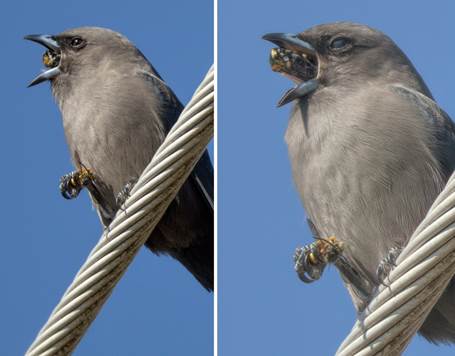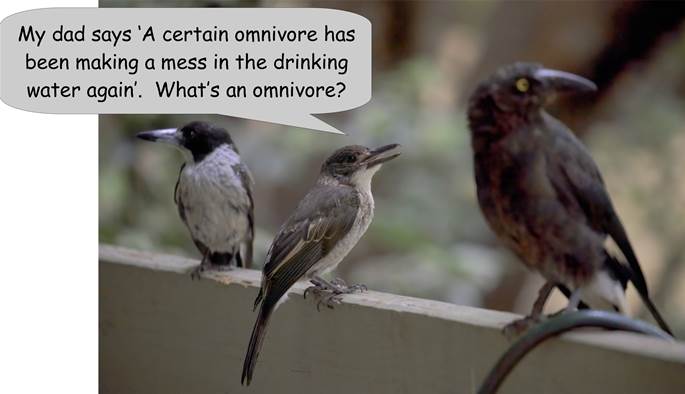Our Grey Butcherbirds have for a number of years, particularly when raising
young, visited for a hand out, generally a bit of mincemeat which they catch
when it is tossed to them
Often they park their reward in a forked tree branch and sit watching it,
and after a minute or two, they regurgitate a black pellet and then eat their
mincemeat or take off with it to feed their young.
My local currawongs disgorge camphor laurel, privet and false tobacco
seeds, which are our main pest weeds along the riverbanks in Gloucester. Sadly
our rivers are no longer running. Perhaps first time ever. Certainly first time
in living memory.
--------------------
Penny Brockman
On Sun, 5 Jan 2020, at 10:51 AM, Anthea Fleming wrote:
A long time ago we had two fledgling Willy
Wagtails in our care, and fed them on meal-worms. Some of the meal-worms
turned into beetles, which the birds pursued and ate. They then
regurgitated the hard wing-cases.
Pied Currawongs regurgitate Pittosporum seeds
and the hard kernels from pomegranates. They also eat the seeds from Currajong
pods, but they must be able to digest them completely.
Anthea Fleming
On 5/01/2020 9:55 am, Geoffrey Dabb
wrote:
Many years ago, my grandparents, who
lived at Upwey, would occasionally put out strips of liver for the
kookaburras. I remember being told (must have been about 1950) that
sometimes they would cough up less desirable stuff they had eaten to enjoy
the liver. I now believe this was regurgitation of undigested remains,
kookaburras being one species that does this routinely. Sometimes a
bird will need to regurgitate obstructive remains to take in more food. My
best example of this is a Dusky Woodswallow on a powerline, clutching a
European Wasp in one foot while it ejected a large pellet of insect remains.
(Photo from last June, Canberra)

This brings us of course to the Pied
Currawong, the regurgitative habits of which have been discussed on more
than one chatline. Messy, crumbly pellets can create a problem at backyard
watering sites that the bird visits, presumably to drink, such as dogs’
water bowls, bird baths and ornamental water features. Australia’s champion
regurgitator I would say (passerine division). Indeed it might be a
contender for the world title, although I believe the American Robin has a
similar reputation.
There is a photo. I might just be
able to fit it in under the limit if I reduce the woodswallow one.
GD

<HR>
<BR> Birding-Aus mailing list
<BR>
<BR> To change settings or unsubscribe visit:
<BR> http://birding-aus.org/mailman/listinfo/birding-aus_birding-aus.org
</HR>
<HR>
<BR> Birding-Aus mailing list
<BR>
<BR> To change settings or unsubscribe visit:
<BR>
http://birding-aus.org/mailman/listinfo/birding-aus_birding-aus.org
</HR>
Attachments:
- image005.jpg
- image006.jpg
<HR>
<BR> Birding-Aus mailing list
<BR>
<BR> To change settings or unsubscribe
visit:
<BR>
http://birding-aus.org/mailman/listinfo/birding-aus_birding-aus.org
</HR>

